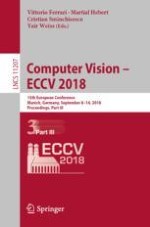2018 | Book
Computer Vision – ECCV 2018
15th European Conference, Munich, Germany, September 8–14, 2018, Proceedings, Part III
Editors: Vittorio Ferrari, Prof. Martial Hebert, Cristian Sminchisescu, Yair Weiss
Publisher: Springer International Publishing
Book Series : Lecture Notes in Computer Science
